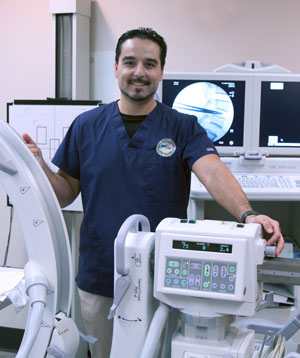Howard Butler
RADIOLOGIC TECHNOLOGY?

WHAT INSPIRED YOUR INTEREST IN RADIOLOGIC TECHNOLOGY?
I knew I wanted a career as sustainable as the healthcare field. I honestly wasn’t 100% sure that it was what I wanted to do. At the time, it just looked interesting to be the person helping doctors diagnose a patient’s illness, whether it is a broken bone or pneumonia. I have some family and friends who are all nurses, but I wanted to do something different in healthcare.
"I questioned myself in the beginning if it was what I really wanted to do, but after spending much time learning and doing the job in clinicals, I now love it!"
WHAT WAS YOUR PREVIOUS CAREER AND WHAT PROMPTED A CAREER CHANGE?
I’ve had previous careers in two major industries - one in real estate as a property manager and one as a sub-contractor for USPS. I was just honestly looking for a change of pace. I wanted a career in something exciting with variety and where I am able to help people. A career in radiologic technology provides that.
WHAT DO YOU LIKE MOST ABOUT YOUR TRAINING AT SJR STATE?
SJR State has the same high-quality equipment that most hospitals and imaging centers in our area use, and there are many clinical sites to choose from. The instructors are wise with many years of experience in the field. Students are also allowed to practice procedures in the labs during school hours. Looking back at it all now, they did a really great job at providing everything I needed to be successful.
WHAT DO YOU CONSIDER TO BE MOST CHALLENGING ABOUT THE PROGRAM?
There are two major parts to the program: the classroom instruction and clinicals. The classroom gives you the knowledge you will need for clinicals and the real world job, and clinicals prepares you for the profession.
There are many expectations of being able to apply what youʼve learned to the clinical setting. Students have to prove competencies in over 50 procedures, which means to be able to complete a procedure from start to finish on your own with competence. In the beginning it can be quite intimidating for some not familiar with the professional side of healthcare. So for me, the clinical side was challenging, but most students in my class would agree that the most challenging part is clinicals. As it is said about many things, you start to understand and become confident with repetition. Once I started to get out of my comfort zone, I then started to become more confident, and then everything really started to click with me.
"The last challenging part was managing home, work, friends and family time. It was difficult in the beginning, but with time and maybe a slight change in lifestyle, it became much easier to manage."
WHAT HAVE YOU LEARNED ABOUT YOURSELF THROUGH THIS JOURNEY?
Iʼve learned to be able to manage my time between the classroom, clinicals, family, work, and leisure time better. Most of all, I have learned to be able to push myself out of my comfort zone and to strive to the next level.
WHAT ADVICE WOULD YOU GIVE TO THOSE CONTEMPLATING ENROLLING IN THIS PROGRAM?
What you put into it is what you will get out of it. If you study and work hard, the benefits will greatly outweigh the short time of hardship, and that hardship is different for everyone. Some struggle in the classroom and some struggle in clinicals. At times you will be intimidated and fail, and trust me you will, but don’t give up.
Pull yourself back up and push yourself out of your comfort zone and just do it. You will surprise yourself of how much you learn.
"It is YOU who has to take that first step, take a chance, push yourself to the next level, and you will greatly reap the rewards in something in which you can be proud."
INTERESTED IN RADIOLOGIC TECHNOLOGY?
https://www.sjrstate.edu/radiologic.html
Prerequisites and admission requirements apply.
Radiographers are medical professionals and members of the health care team who:
- Perform diagnostic imaging procedures such as X-ray examinations of the bones, heart, lungs, and abdomen to be used for analyzing medical issues
- Work in a variety of health care settings:
- Hospitals
- Urgent care centers and free standing emergency centers
- Doctor's offices and
- Diagnostic imaging centers